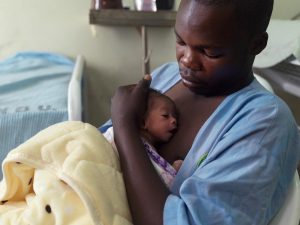
Victor Otieno is a new father to twins and is successfully completeing KMC which relieves the burden on his wife. Save the Children is strengthening the skills and capacity of health providers in seven hospitals located in the Langata area of Nairobi, Kenya, so that they can deliver higher quality care to preterm and low-birth-weight babies. The project is targeting to reach 2,200 new born babie each year. Kangaroo Mother Care (KMC) is the current recommended practice to care for stable preterm babies in Kenya. For babies, KMC promotes faster weight gain due to better thermoregulation and improved breastfeeding and therefore shorter hospital stay. KMC improves bonding between mother and baby and empowers mothers to play an active role in care for the newborn. KMC reduces dependency on incubators, does not require additional nursing staff and reduces cost per patient due to shorter hospital stays providing benefits for the health facility.
Background
Increasing the utilization of facility-based care for women and newborns in low-resource settings can reduce maternal and newborn morbidity and mortality. Men influence whether women and newborns receive care because they often control financial resources and household decisions. This influence can have negative effects if men misjudge or ignore danger signs or are unwilling or unable to pay for care. Men can also positively affect their families’ health by helping plan for delivery, supplementing women’s knowledge about danger signs, and supporting the use of facility-based care. Because of these positive implications, researchers have called for increased male involvement in maternal and newborn health. However, data gathered directly from men to inform programs are lacking.
Methods
This study draws on in-depth interviews with 27 men in Morogoro Region, Tanzania whose partners delivered in the previous 14 months. Debriefings took place throughout data collection. Interview transcripts were analyzed inductively to identify relevant themes and devise an analysis questionnaire, subsequently applied deductively to all transcripts.
Results
Study findings add a partner-focused dimension to the three delays model of maternal care seeking. Men in the study often, though not universally, described facilitating access to care for women and newborns at each point along this care-seeking continuum (deciding to seek care, reaching a facility, and receiving care). Specifically, men reported taking ownership of their role as decision makers and described themselves as supportive of facility-based care. Men described arranging transport and accompanying their partners to facilities, especially for non-routine care. Men also discussed purchasing supplies and medications, acting as patient advocates, and registering complaints about health services. In addition, men described barriers to their involvement including a lack of knowledge, the need to focus on income-generating activities, the cost of care, and policies limiting male involvement at facilities.
Conclusion
Men can leverage their influence over household resources and decision making to facilitate care seeking and navigate challenges accessing care for women and newborns. Examining these findings from men and understanding the barriers they face can help inform interventions that encourage men to be positively and proactively involved in maternal and newborn health.